9 books about Ecclesiology
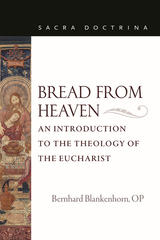
Bread from Heaven
An Introduction to the Theology of the Eucharist
Bernhard Blankenhorn
Catholic University of America Press, 2021
Bread from Heaven offers a contemporary theological synthesis on the Eucharist that brings together classical and critical biblical exegesis, debates on the early history of the Christian liturgy, patristic doctrine, the teachings offered by the Councils of Florence, Trent and Vatican II, and the Church’s lex orandi, all within a framework provided by the Eucharistic theology of Thomas Aquinas.
The volume begins with Christ’s Bread of Life discourse in John 6, in light of the Old Testament theme of the manna, and the Synoptic accounts of the Last Supper. These biblical texts offer solid foundation for a theology of Eucharistic sacrifice, presence and Communion. It then continues with a historical and systematic study of the institution of the Eucharist by Christ, with special attention given to the emergence of the first Eucharistic prayers. Then follows a survey of key Christological and ecclesiological themes which undergird Eucharistic theology. The chapters on Eucharistic sacrifice and presence form the heart of the work. Here, the focus moves to key conciliar, patristic and Thomistic insights on these themes. Bread from Heaven clarifies misunderstandings of Eucharistic sacrifice and renders transubstantiation accessible to beginners.
Blankenhorn concludes with a study of the consecration, the minister of the Eucharist and the fruits of communion. The chapter on the debate over the words of institution and the epiclesis gives a fresh perspective that integrates both eastern and western tradition. The study of the Eucharistic celebrant strikes a balance between a spirituality of the priest as acting in persona Christi and of the priest as praying in persona ecclesiae. The concluding chapter centers on the Eucharist’s unitive, mystical fruits in the Church.
This textbook is ideal for an advanced undergraduate or graduate course on Eucharistic theology. It also seeks to advance the debate on several controversial historical and speculative issues in sacramental theology.
[more]
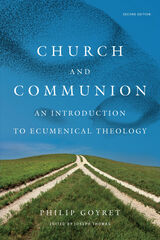
Church and Communion
An Introduction to Ecumenical Theology, Second Edition
Philip Goyret
Catholic University of America Press, 2021
This book is about ecumenism, from a Catholic point of view. The first part, chapters 1 and 2, describe the history of divisions within the Church, as well as of the efforts to bring about Christian unity. The second part examines Ecumenism from a systematic theological perspective.
This first part takes into account the different factors that led to definitive ruptures within the Church, which usually are not only theological. The text gives useful information about what happened after the respective divisions as well as about the various attempts to restore unity, the development of the Ecumenical Movement in the 20th Century, and the current situation of ecumenical dialogue within the Catholic Church. While offering insight into the sad history that has led to the present disunity, this work also highlights the way Christians have sought to bring to fulfill the petition of Christ that his disciples might be one, as He and the Father are one.
The second part―chapters three, four and five―offers a systematic theological analysis of unity in the Church, from the point of view of dogmatic theology. We find here an explanation of the Catholic concept of ecumenism, of how Catholic theology understands the unity of the Church, and, finally, of the Catholic principles which sustain the efforts for regaining unity in the Church. The Second Vatican Council, and particularly the Constitution Lumen gentium and the Decree Unitatis redintegratio, are at the foundation of these reflections. At the same time, since the theology of the Church and the life of the Church are intimately connected, there is a profound link between this dogmatic section and the earlier historical section.
The last chapter, about the practice of ecumenism, is also written from a theological perspective, but with more links with life and spirituality. The chapter recalls that ecumenism can never simply remain a set of theological principles, but rather inspires an attitude and action in charity which are essential to the Christian life.
[more]
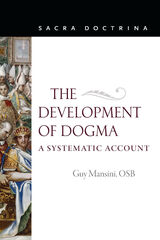
The Development of Dogma
A Systematic Account
Guy Mansini, OSB
Catholic University of America Press, 2023
The Development of Dogma examines the nature of dogmatic statements and the causes of development. It devotes particular attention to the emergence of the form of dogmatic statements at the Council of Nicaea, but notes how this form is anticipated in the New Testament. It situates dogma and its development within the matrix of the great fundamental theological realities of Scripture, Tradition, and Magisterium. Fr. Mansini examines at some length how the Church comes to recognize a development as a genuine development rather than as a distortion of the word of God. The Development of Dogma is especially valuable today for its discussion and defense of the philosophical presuppositions of dogma, which are often simply presupposed but should not be ignored in a complete account of development. These presuppositions touch on fundamental philosophical issues, including the nature of knowledge, the objectivity and trustworthiness of names, and the various logical forms employed in understanding how development is related to a closed revelation. The historicity of human knowledge is also addressed, and the role of dogma itself in heading off the extreme relativism the historical nature of man is supposed to imply for ecclesial faith and life. The Church's dogma about dogma enunciated at the First Vatican Council is also examined. The role of certain fundamental concepts in understanding the possibility of the irreformability of dogma it speaks of is expressly addressed—concepts in principle accessible to all human beings and that enable a trans-cultural, trans-temporal proposal and reception of revealed truth.
[more]
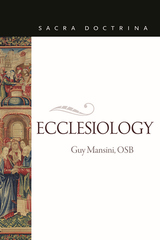
Ecclesiology
Guy Mansini, OSB
Catholic University of America Press, 2021
The first part of the book explains the antecedent probability both of revelation and of God’s institution of a church. It is ecclesiology in the mode of fundamental theology.
The second part rounds up what Scripture and Tradition teach about the Church under the heads of the People of God, the Temple of the Holy Spirit, the Bride of Christ, and the Body of Christ. The chapters present this thematic material under each head as a unified whole, across the Testaments, with each chapter keyed to one of the “marks” of the Church: the catholicity of the people of God, the apostolicity of the ministers of the messianic temple, the holiness of the Bride of Christ, and the unity of the Body of Christ. This already organizes things in a proto-systematic frame.
The third part of the book gives systematic exploration, in reverse order, to the unity of the Church, with attention to non-Catholic ecclesial communities and churches, to the holiness of the Church, objective and subjective, to the apostolicity of the Church and her mediation of revealed truth and grace, and to the catholicity of the Church, with attention to non-Christian religions.
The center of the book, on the definition of the Church as the sacrament of communion, renders recent French Dominican ecclesiology in a form more accessible to undergraduates and seminarians, rooting it in the New Testament teachings on communion and mysterion. The book concludes with a strenuous argument for the necessity of the Church and her mission of evangelization. Thus, the trajectory of the book is from the naturally knowable antecedent probability of the Church to its revealed necessity.
[more]

Light for the Nations
The Scriptures on the Universal Mission of Israel and the Church
Luis Sanchez-Navarro
Catholic University of America Press, 2024
Universality belongs to the very being of the Catholic Church. This claim of the Gospel is rooted in the ministry of Jesus, witnessed to by the canonical Gospels and the other books of the New Testament, all of which present the universal openness of salvation as a fulfillment of the Scriptures of Israel. In this book, after addressing the universality of salvation in the writings of the Old Covenant, we examine the differentiated and concordant witness of the synoptic Gospels, John and Paul, as well as the Letter to the Hebrews and the Apocalypse. In this way, we intend to show how this apostolic witness responds to the will of the Lord Jesus, while highlighting its harmony with Torah, Prophets and Writings.
Light for the Nations, by reviewing the main biblical passages on the universal dimension of salvation, aims to show how the fact that the Gospel of Jesus Christ has a claim to universality does not diminish, but rather enhances, the importance of the people of the first Covenant: Israel is called to be an active mediator of salvation. The canonical perspective is based on a differentiated exegetical study of each testimony. The scope is broad, since this theme of biblical theology is also relevant for Christology and soteriology, for anthropology and for ecclesiology. The main contribution lies in showing how the various biblical testimonies, in their diversity (which is fully taken into account), offer at the same time a concurring testimony on this fundamental question of Christian theology,
forming a true symphony within its polyphony.
[more]
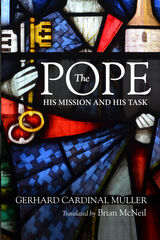
The Pope
His Mission and His Task
Gerhard Cardinal Muller
Catholic University of America Press, 2021
This book offers an introduction to the theological and historical aspects of the papacy, an office and institution that is unique in this world. Throughout its history up to our present time, the Petrine ministry is both fascinating and challenging to people, both inside and outside the Catholic Church.
Gerhard Cardinal Müller speaks from a particular and personal viewpoint, including his experience of working closely with the pope every day as Prefect of the Congregation for the Doctrine of the Faith. He addresses, in particular, those dimensions of the papal office which are crucial for understanding more deeply the pope as a visible principle of the church’s unity.
500 years after the Protestant reformation, the book offers insights into the ecumenical controversies about the papacy throughout the centuries, in their historical context. The book also exposes prejudices and cliches, and points to the authentic foundation of the Petrine ministry.
[more]

Theology as an Ecclesial Discipline
Ressourcement and Dialogue
J. Augustine Di Noia
Catholic University of America Press, 2024
The practice of theology depends in part on asking the right questions. Not any sorts of questions, not idle questions, nor questions framed entirely by our own experience or the great issues of our times, but good theological questions focus the mind of the inquirer on the endlessly intelligible self-revelation of God to which the Sacred Scripture bears witness. Our own questions and the great questions of our times have a place, as long as they are purged of the ideological outlooks that can suppress or obscure the questions that the sacra pagina itself presses upon us.
Among the essays gathered in Theology as an Ecclesial Discipline, the first set directs the reader’s attention precisely to questions that trace the distinctive features of the nature of theology itself. What are the principles and scope of the field of theology as practiced by believers in an ecclesial context? Are historical-critical methods of exegesis compatible with a properly theological interpretation of the Scriptures? How can theology have a place in the academy as an intellectual discipline if the Magisterium seems to limit the scope of its inquiries? The second part considers a range of questions that preoccupy contemporary Protestant and Catholic theologians. Can the names Father, Son and Holy Spirit be replaced by more inclusive titles in doctrine and liturgy? By placing humanity at the center of theological investigation, is Christian humanism distinct from secular humanism? How can we be guilty of a sin committed by our first ancestors? Can the Christian vision of procreative human sexuality survive the cultural onslaught of the sexual revolution? The questions in the third part of this book arise from Catholic dialogue with non-Christian religions, or with other Christian communities, or with conceptions of a cosmos in ecological crisis. Is there a future for Catholic theology of religions? How can people who do not believe in Christ be saved? Is the cosmos a safe environment for human beings, or, alternatively, how can the cosmos be protected from human depredation? Can the concept of “church” stretch far enough to encompass Christian communities that see themselves as strictly local and independent bodies?
[more]
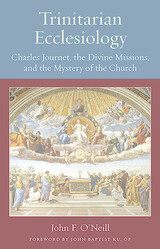
Trinitarian Ecclesiology
Charles Journet, the Divine Missions, and the Mystery of the Church
John F. O'Neill
Catholic University of America Press, 2023
Venerable Fulton Sheen once famously said that “There are not one hundred people in the United States who hate the Catholic Church, but there are millions who hate what they wrongly perceive the Catholic Church to be – which is, of course, quite a different thing.” What is the true understanding of the mystery of the Church? In Lumen Gentium, the Church famously identifies herself as the sacrament of salvation, and various attempts have been made at developing an ecclesiology rooted in this idea. Another approach, nevertheless, prominent in the opening chapter of Lumen Gentium, is the relation of the Church to the Trinity in light of the divine missions, especially those of the Incarnation and Pentecost.
Trinitarian Ecclesiology is an example of this approach to the mystery of the Church that places the divine missions at the head and the heart of the work. The order of Journet's work is based on the four causes of the Church. Journet situates the treatise on the hierarchy in its proper place as belonging to the efficient cause of the Church in order to treat the more central mystery of the Church in her formal and material causes, namely the sanctifying gift of fully Christic charity and its visible manifestation.
While Journet’s magisterial work may already be identified as a Trinitarian Ecclesiology, recent research into the Trinitarian theology of St. Thomas Aquinas has deepened our understanding of his teaching, particularly in the way that creatures can relate to the divine persons in the divine missions. With a clearer understanding of the relation of creatures to the divine persons rooted in grace and its effects, a deeper vision of the mystery of the Church emerges, one that sees the Church as the visible mission of the Holy Spirit, inseparably joined with the visible mission of the Son in the Incarnation. The Great Mystery of Christ and the Church is the unity of the visible missions of the Son and the Spirit who have been sent into the world for our salvation.
[more]
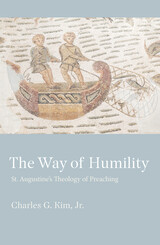
The Way of Humility
St. Augustine's Theology of Preaching
Charles J. Kim
Catholic University of America Press, 2023
For Augustine, that the Word became flesh transformed a merely human understanding of the virtues and grounds all virtue in humility. The Way of Humility: Augustine’s Theology of Preaching explores how this truth became a new paradigm for understanding the scriptures and thus, how Augustine embodied the virtue in the preaching of the scriptures. One of Augustine’s most devoted students, Possidius, said that anyone can learn from reading Augustine, but “those were able to profit still more who could hear him speak in church and see him with their own eyes. Truly, he was indeed one of those of whom it is written, ‘speak this way and act the same way.’” The Way of Humility searches for evidence of the virtue of humility in action through the preaching of the humble Word in the sermons of Augustine.
Many know of Augustine through his more famous treatises but few have encountered the Doctor of Grace where he had his most immediate impact, preaching. The Way of Humility follows the sermons through several traditional theological loci, ecclesiology, Christology, soteriology to uncover what can be learned about Augustine’s theology through the way he preached to a mixed audience of urbanites and rustics, many of whom did not have the benefit of a formal education. Throughout the book, we see the interplay between Augustine’s action in speech and Augustine’s more direct statements on his theology of Preaching. Through handing over Christ in his sermons, he became himself an example of humility for the congregation on their journey toward the final end for all people, the Beatific Vision.
[more]
READERS
Browse our collection.
PUBLISHERS
See BiblioVault's publisher services.
STUDENT SERVICES
Files for college accessibility offices.
UChicago Accessibility Resources
home | accessibility | search | about | contact us
BiblioVault ® 2001 - 2024
The University of Chicago Press









